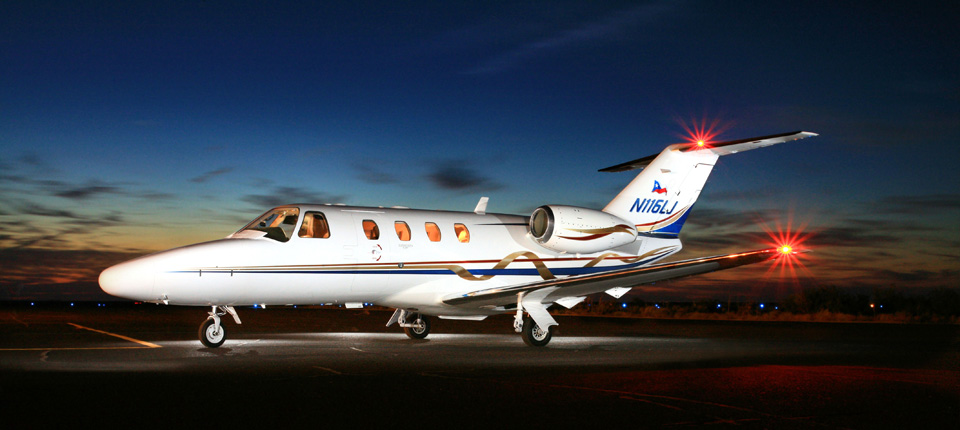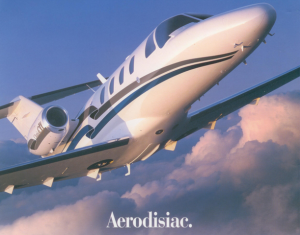

Aerodisiac – The Cessna CitationJet: A Revolutionary Business Aircraft that Still sets the Standard in its Class. | The JetAv Blog by John Hall
I was privileged to be an original member of Cessna’s CitationJet Division and found writing this article a wonderful stroll down memory lane. Introduced at the 1989 National Business Aircraft Association Convention, the CitationJet combined a number of next generation material, engineering, computer and manufacturing technologies with an integrated design team that included all functional area disciplines including end-user input. The CitationJet, Boeing 777 and their major component manufacturers such as engines and avionics were the first to integrate these capabilities and techniques which form the basis for every aircraft design synthesis since that time.
Many things coalesced during this period to make the Model 525 Series aircraft possible, perhaps least appreciated, but vitally important, was the strength of the organization at Cessna. Cessna had the advantage of having a stable senior management team that had a seasoned core engineering group that despite the strength of their abilities was not allowed, or did not assume to, dominate the other functional areas. This well-balanced approach allowed the breakthrough in teamwork/communication and breakdown of protective internal walls; thus, realizing the full promise of CADAM CATIA design.
The CitationJet team effort started with its revolutionary fundamentals: new generation Williams-Rolls FJ44-1A engines, a Citation-first laminar flow wing, and a process focused on simplicity, safety, efficiency, reliability, durability and maintainability. With its trailing link landing gear, T-tail and polished wing leading edges, there are few that will argue its ramp appeal, but it’s the CitationJet’s handling qualities, safety record and durability that made it exceptional. The CitationJet was touted to be the first single-pilot certified business jet that would cost less to own and operate than competitive turboprop aircraft. Cessna delivered on that promise. With Certification in 1992 and initial deliveries beginning in 1993, the 525 Series aircraft is one of the most successful business jet product lines with deliveries exceeding 1300 aircraft. An impressive industry feat where many announce and few deliver.
Cessna, well known for its creative ads, capitalized on this success by touting “It has broken the record formerly held by hotcakes”, and my personal favorite, “Aerodisiac”. The design philosophy behind the CitationJet was simple: easy to fly, easy to own. Design a maintainable, pilot-friendly aircraft that would provide jet performance and low operating costs at a competitive price of under $3 million dollars (sound familiar Mustang fans?). While the CitationJet’s maximum weight of 10,500 allowed for certification under FAR Part 23, take-off and landing performance were certified to more stringent Part 25 safety standards while maintaining excellent short field characteristics. The CitationJet also offers cruise speeds up to 380 knots at altitudes up to 41,000 feet.
A total of 359 CitationJet’s were delivered between 1993 and 2000, all offering a similar Honeywell two-tube pilot’s EFIS, a CNI-5000 “Silver Crown” radio stack and electro-mechanical co-pilot instruments. The avionics option list was fairly short, limited primarily to FMS type, ADF, HF and DME. Fairly basic by today’s standards, but still capable and easily upgradeable with modern bells and whistles. Some have replaced the CNI-5000 stack with newer Garmin equipment which brings both electronic charts and XM weather capability into the cockpit, and Cessna now offers a complete G1000 upgrade via STC.
Interior configuration is essentially identical in all CitationJet’s – pilot, co-pilot (or additional passenger), 4 seats in a club arrangement and a side facing seat just aft of the co-pilot. All feature a semi-private (curtain, no hard divider) aft lavatory which can be either belted on non-belted, flushing or non-flushing. More than ample baggage capability is provided by forward, aft and internal baggage compartments including the ability to carry skis in the aft compartment when equipped with the extended ski shelf. I will never forget the demonstration flight where the client and his family pulled up with a Chevy Suburban full of luggage and, just as we loaded the last suitcase, his wife pulled out an 1990’s vintage “Ab-Roller”. Somehow it fit. The CJ can carry a load!
The CitationJet truly stands the test of time. While not quite as efficient as its newer sibling, the Mustang, the CJ still offers great efficiencies and predictable, low operating costs with available hourly engine and airframe maintenance programs. When compared to the Mustang, you get an additional passenger seat (or two with the belted toilet) plus an advantage in speed, range and payload capability. Eighty percent United States business flying is between a triangle formed by the Midwest, New England and the Southeast while another ten percent is up and down the West coast. The CJ thrives within this mission matrix.
Like the rest of the business jet market, we have seen inventories increase, prices drop and sales velocity slow on the CitationJet in recent years. The CitationJet inventory is approaching 20% of aircraft built, almost double the historical norm. With current prices ranging anywhere from the low to mid $1 million range, this presents a tremendous opportunity for buyer’s seeking a single-pilot capable aircraft with excellent economics. In fact, a very persuasive argument can be made that the CitationJet is the value entry level business jet in terms of performance for the dollar. Given the outstanding combination of price, performance and economy, the CitationJet represents one of the best aircraft investment values in the market today.
To read additional Blogs on the CitationJet click the title below:
Making the CitationJet Even Better – Garmin G1000 Upgrade | The JetAv Blog
Premier Jet invites your feedback via the comment section below.
